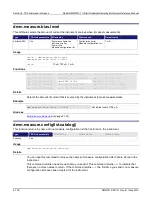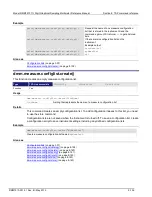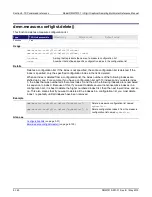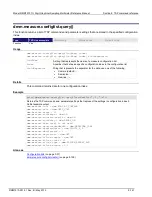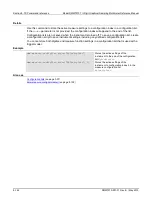
Section 8: TSP command reference
Model DMM7510 7½ Digit Graphical Sampling Multimeter Reference Manual
8-152
DMM7510-901-01 Rev. B / May 2015
dmm.measure.filter.type
This attribute defines the type of averaging filter that is used for the selected function when the filter is enabled.
Type
TSP-Link accessible
Affected by
Where saved
Default value
Attribute (RW)
Yes
Restore configuration
Instrument reset
Power cycle
Measure configuration list
Configuration script
Measure configuration list
dmm.FILTER_REPEAT_AVG
Usage
type
= dmm.measure.filter.type
dmm.measure.filter.type =
type
type
The filter type setting:
•
Repeating filter:
dmm.FILTER_REPEAT_AVG
•
Moving filter:
dmm.FILTER_MOVING_AVG
Functions
dmm.FUNC_DC_VOLTAGE
dmm.FUNC_RESISTANCE
dmm.FUNC_ACV_FREQUENCY
dmm.FUNC_AC_VOLTAGE
dmm.FUNC_4W_RESISTANCE
dmm.FUNC_ACV_PERIOD
dmm.FUNC_DC_CURRENT
dmm.FUNC_DIODE
dmm.FUNC_DCV_RATIO
dmm.FUNC_AC_CURRENT
dmm.FUNC_CAPACITANCE
dmm.FUNC_DIGITIZE_CURRENT
dmm.FUNC_TEMPERATURE
dmm.FUNC_CONTINUITY
dmm.FUNC_DIGITIZE_VOLTAGE
Details
When the repeating average filter is selected, a set of measurements are made. These
measurements are stored in a measurement stack and averaged together to produce the averaged
sample. Once the averaged sample is produced, the stack is flushed and the next set of data is used
to produce the next averaged sample. This type of filter is the slowest, since the stack must be
completely filled before an averaged sample can be produced.
When the moving average filter is selected, the measurements are added to the stack continuously
on a first-in, first-out basis. As each measurement is made, the oldest measurement is removed from
the stack. A new averaged sample is produced using the new measurement and the data that is now
in the stack.
When the moving average filter is first selected, the stack is empty. When the first measurement is
made, it is copied into all the stack locations to fill the stack. A true average is not produced until the
stack is filled with new measurements. The size of the stack is determined by the filter count setting.
The repeating average filter produces slower results, but produces more stable results than the
moving average filter. For either method, the greater the number of measurements that are averaged,
the slower the averaged sample rate, but the lower the noise error. Trade-offs between speed and
noise are normally required to tailor the instrumentation to your measurement application.
Example
dmm.measure.func = dmm.FUNC_DC_CURRENT
dmm.measure.filter.type = dmm.FILTER_MOVING_AVG
dmm.measure.filter.enable = dmm.ON
Set the measurement function to DC
current. Set the filter type to moving average
and enable filtered measurements.
Also see
(on page 8-151)

